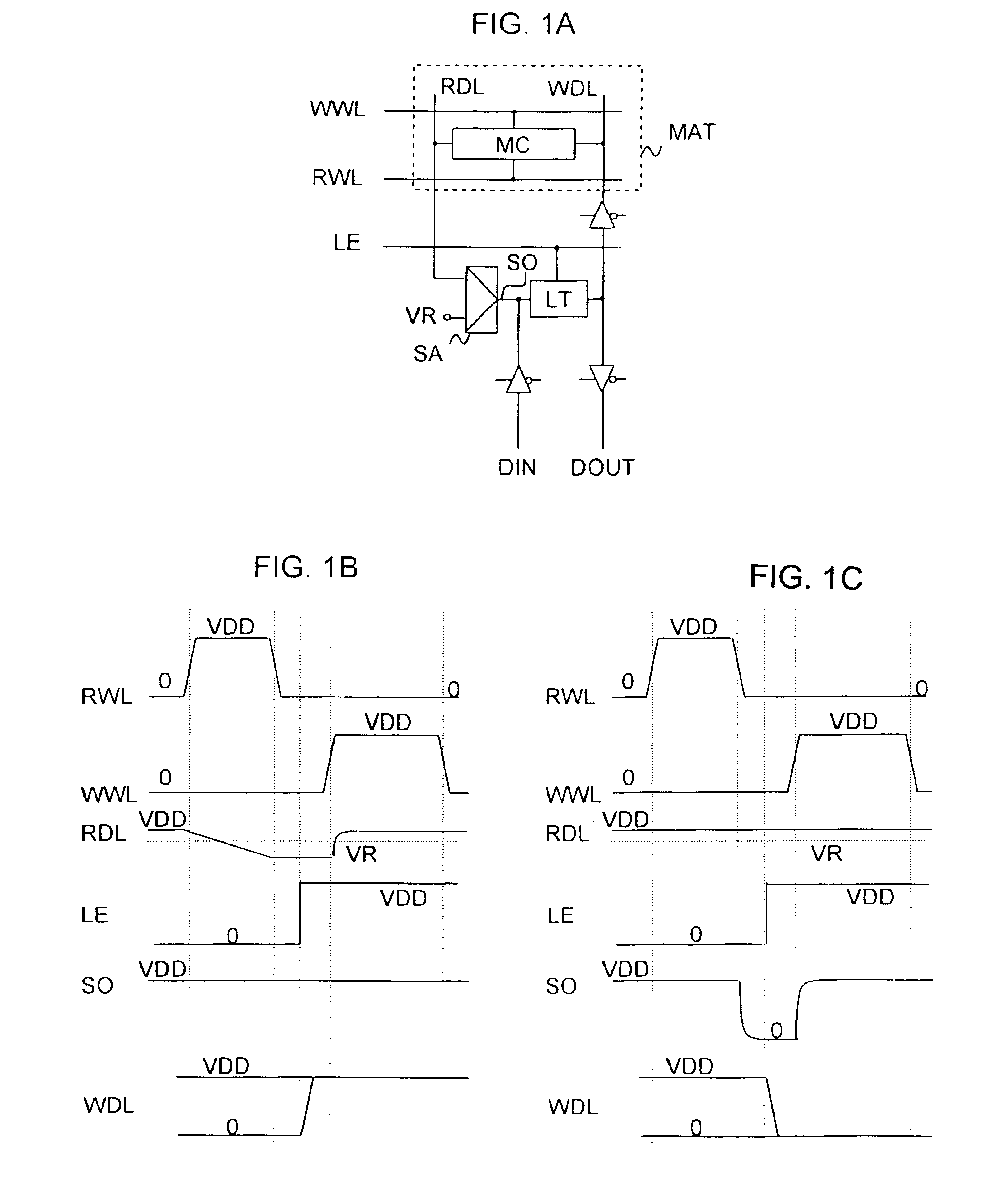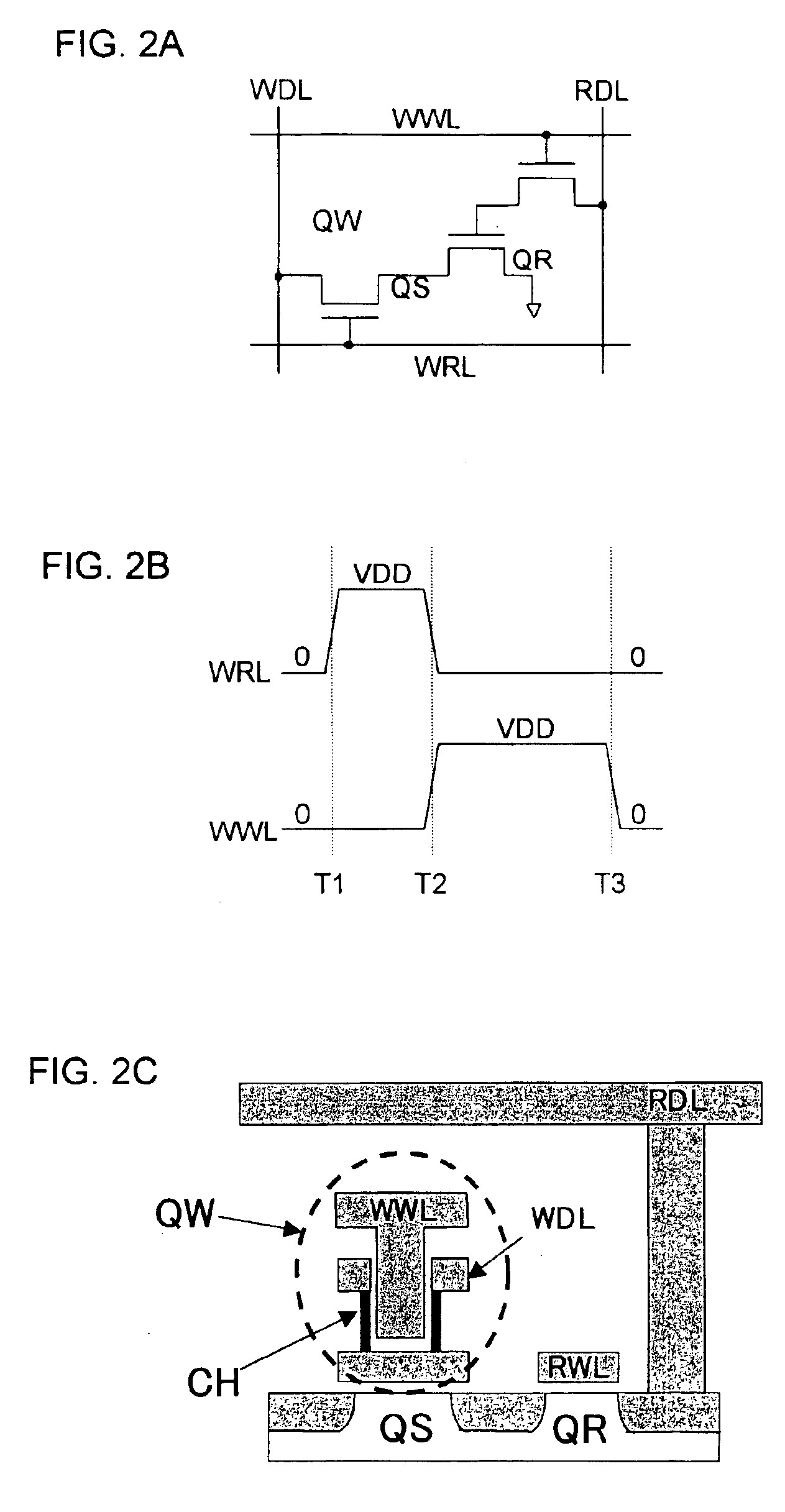Semiconductor memory pipeline buffer
a technology of memory pipeline and memory buffer, which is applied in the field of memory pipeline, can solve the problems of large area, large processing overhead, and large size of the device, and achieve the effect of reducing the access time reducing the effective access speed of the cache memory, and negligible area and processing overhead
- Summary
- Abstract
- Description
- Claims
- Application Information
AI Technical Summary
Benefits of technology
Problems solved by technology
Method used
Image
Examples
first embodiment
[0038]FIG. 1A is a circuit diagram of a memory circuit, in accordance with the present invention. The block consists of a mat MAT of memory cells arranged in columns and rows and a single memory cell MC is accessed by a read word line RWL, a write word line WWL, a read data line RDL, and a write data line WDL. A sense amplifier SA discriminates the data on the read data line by comparing the signal with a reference signal VR. The output SO of the sense amplifier is connected to the input of a latch element LT. In addition, input data line DIN for the column is also connected to the input of the latch element through a switch element. The output of the latch is connected to the write data line WDL through a switch and presents the write data to the accessed cell. Furthermore, the output of the latch is connected to the data out line DOUT through a buffer used to output read data to the microprocessor.
[0039]Before the access characteristics of this memory architecture are presented, a...
second embodiment
[0060]the present invention presents a structure similar to the first embodiment in which two separate memory mats share a single sense amplifier SA and latch circuit LT.
[0061]FIG. 10A shows the circuit diagram of a pair of array columns and the common sense amplifier and latch circuits, in accordance with the second embodiment of the present invention.
[0062]FIG. 10B shows exemplary access waveforms for the circuitry of FIG. 10A, in accordance with the second embodiment of the present invention. In the second embodiment, the memory is composed of a set of upper memory mats UMAT and lower memory mats LMAT. The cells are controlled by row signals including the read word lines URWL, LRWL and the write word lines UWWL, LWWL. In addition, the mats are divided into columns of cells that are accessed through read data lines URDL, LRDL and write data lines UWDL, LWDL. In this embodiment, the upper read data line URDL and lower write data line LRDL are connected to a single sense amplifier S...
third embodiment
[0065]the present invention concerns memory arrays in which the read phase is much shorter than the write phase of the write cycle.
[0066]FIG. 11A shows the circuit diagram of a single array column, in accordance with the third embodiment of the present invention.
[0067]FIG. 11B shows exemplary access waveforms for the circuitry of FIG. 11A, in accordance with the third embodiment of the present invention. A fundamental difference here from the first embodiment is that several latches are placed between the sense amplifier SA and the write data line WDL instead of a single latch. With this configuration, the effective write access speed of the memory array can be increased versus that in the first embodiment. For a write phase that is several times slower than the read phase, the access speed of the first embodiment is limited to the speed of the write phase. In this embodiment, the effective access speed is limited to the speed of the faster read phase.
[0068]An analysis of the circui...
PUM
 Login to View More
Login to View More Abstract
Description
Claims
Application Information
 Login to View More
Login to View More - R&D
- Intellectual Property
- Life Sciences
- Materials
- Tech Scout
- Unparalleled Data Quality
- Higher Quality Content
- 60% Fewer Hallucinations
Browse by: Latest US Patents, China's latest patents, Technical Efficacy Thesaurus, Application Domain, Technology Topic, Popular Technical Reports.
© 2025 PatSnap. All rights reserved.Legal|Privacy policy|Modern Slavery Act Transparency Statement|Sitemap|About US| Contact US: help@patsnap.com



